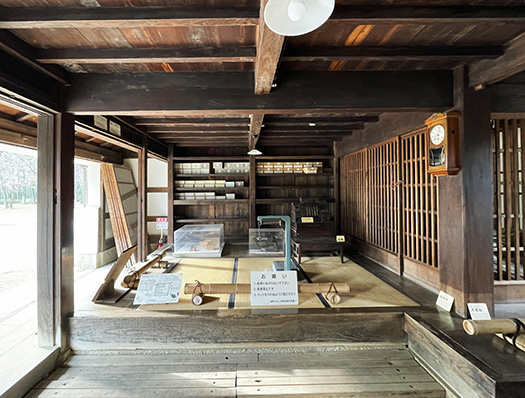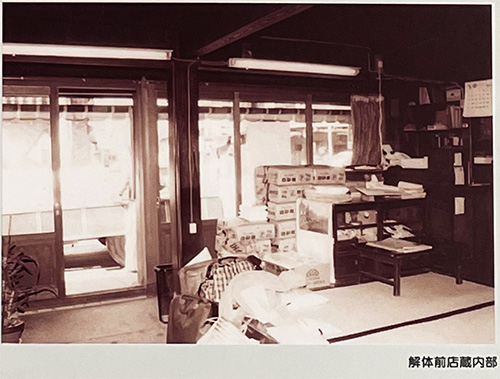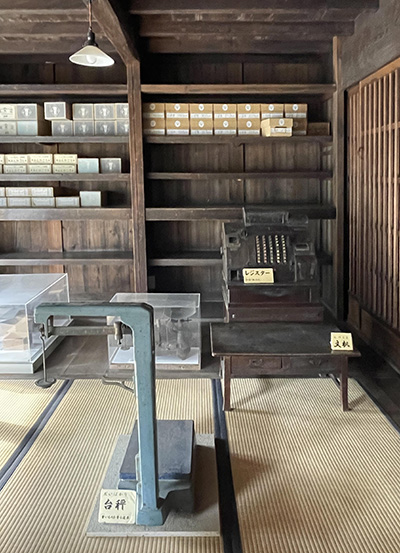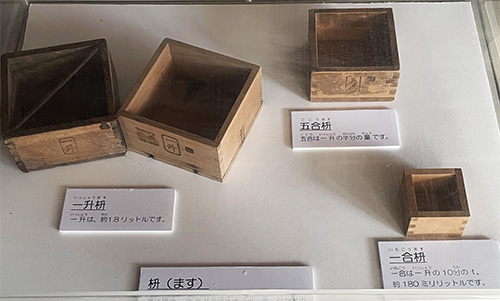


江戸期には京都で旺盛に盛り上がった呉服産業があり、綿の生産には大量の魚肥が必要とされて、その需要が蝦夷地のニシン漁の漁獲・運送を盛んにさせたことが知られる。高田屋嘉兵衛という事業者の成功には、京阪神地域での産業革命、ビジネス革命があったことが偲ばれる。社会が沸騰するような農産物の多様化・産業化が進んだのでしょう。
呉服産業というのはまったくのファッション産業だけれど、江戸期の社会発展はそういう産業基盤条件を形成していったということ。幕府が繰り返し「贅沢禁止令」みたいなものを発出した背景にはそういった社会発展に伴う強い需要があったと言われる。
また幕末期以降には横浜の開港、海外貿易の開始という経済的インパクトが起こって、とくに関東一円では「養蚕」業が旺盛に発展した。その蚕のためのクワの生産が空前の需要を生んでいった。
そうした商品作物の生産競争の中で、単位面積あたりの収量を左右する「肥料」に農家経済は依存を深めていった事情が垣間見える。肥料屋さんという商売が大きく成立した背景には、江戸期以降からの多様な商品作物の生産の盛り上がりが大きい。日本資本主義の勃興期そのものだろうか。とくに消費都市大都会・江戸の需要に応える意味合いがこの浦和宿ではきわめて大きかったのでしょう。浦和周辺地域からの江戸・東京への商品作物出荷も盛んだったことだろう。
上の写真は浦和の町家のなかでも広い間口を開いているこの店舗のようす。江戸期・明治大正戦前期には大八車などで「肥料」搬出入が繰り返された。運搬動力としては基本的には馬が使われたのでしょう。3枚目の写真は昭和30年代の店舗の写真だそうですが、よくみると店の前に「オート三輪」とおぼしきトラック車両が横付けされて肥料が積み出されている。
買い付けに訪れる農家や「仲買人」たちがこの肥料店で購入して、店舗奥側のバックヤードから運び出された商品がこの店先から出荷されていった状況なのだろう。
明治以降、開拓が進展した北海道札幌でも、よく似た光景が展開していて、幹線道路「石山道路」に面していたわたしの生家前には運搬に使役された馬たちの「馬糞風」が吹いていた。そして運搬動力はこの写真のようにオート三輪が活躍した。たぶん似た光景がこの浦和宿でも見られていたに違いない。自分自身が体験した幼年期の記憶がシンクロしてくる。


店舗内の風景としては「量り売り」のための計量器がドンと鎮座している。大量取引の場合はこうした計量器が使用され、より小口取引の場合には、マスでの販売が行われたというような説明が行われていた。まことに画期ある商取引の状況が活写されている。
昨日よりも今日、そしてあしたはもっと良くなるということを多くの人びとが信じていた。
English version⬇
Fertilizer, the backbone of the commodity crop economy.
The air is filled with the vitality of the contact point of the commodity crop economy, the active buying, selling, and transporting of fertilizers. The breath of a manufacturing society. The breath of a manufacturing society.
It is known that the kimono industry flourished in Kyoto during the Edo period, and that the production of cotton required large amounts of fish manure, the demand for which stimulated the fishing and transportation of herring in the Ezo region. The success of an entrepreneur named Takataya Kahei is remembered for the industrial and business revolution in the Kyoto-Osaka-Kobe region. It must have been the diversification and industrialization of agricultural products that brought society to a boiling point.
The kimono industry is a totally fashionable industry, but the social development during the Edo period formed such industrial base conditions. It is said that there was a strong demand for such products due to social development, which was the reason why the shogunate repeatedly issued a kind of “luxury prohibition.
In addition, after the end of the Edo period, the opening of the port of Yokohama and the start of overseas trade had an economic impact, and the “sericulture” industry developed vigorously, especially in the Kanto area. The production of mulberry for silkworms created unprecedented demand.
In the midst of such competition in the production of commodity crops, the farm economy became increasingly dependent on “fertilizers,” which were crucial to the yield per unit area. The background to the establishment of the fertilizer business is largely due to the rise in the production of various commodity crops since the Edo period. Was this the very period of the rise of Japanese capitalism? In particular, the Urawa-juku must have been extremely significant in meeting the demands of the consumer metropolis of Edo. The shipment of commodities from the Urawa area to Edo and Tokyo must have been very active.
The photo above shows a store with a wide frontage among the town houses in Urawa. During the Edo period and the Meiji-Taisho prewar period, “fertilizer” was repeatedly carried in and out of Urawa by large carts and other vehicles. The third photo is said to be a photo of the store from the 1950s, and if you look closely, you can see a truck vehicle that looks like an “auto three-wheeler” parked in front of the store, and fertilizers are being loaded out.
It is likely that farmers and “middlemen” visiting the store to buy fertilizers purchased the products at this store, and the products were shipped out from the back yard at the rear of the store.
In Sapporo, Hokkaido, where pioneer settlers developed after the Meiji period, a similar scene was often seen, with the “horse dung wind” of horses used for transportation blowing in front of my birthplace, which faced the Ishiyama Road, a main road. As you can see in the photo, three-wheeled motorcycles were used for transportation. A similar scene must have been seen at the Urawa Inn. My own childhood memories of the Urawa Inn are synchronized with this scene.
As a view inside the store, a weighing scale for “weighing and selling” is sitting on the floor. The explanation was that such a scale was used for large volume transactions, while mass sales were used for smaller transactions. This is truly a vivid picture of business transactions in an epoch-making period.
Many people believed that today and tomorrow would be better than yesterday.
Posted on 7月 17th, 2023 by 三木 奎吾
Filed under: 住宅マーケティング, 日本社会・文化研究







コメントを投稿
「※誹謗中傷や、悪意のある書き込み、営利目的などのコメントを防ぐために、投稿された全てのコメントは一時的に保留されますのでご了承ください。」
You must be logged in to post a comment.